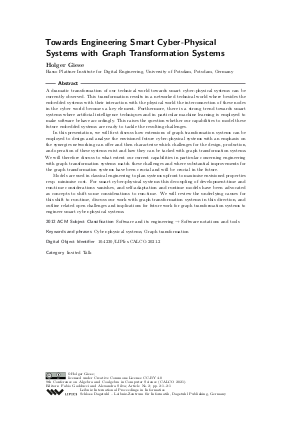Towards Engineering Smart Cyber-Physical Systems with Graph Transformation Systems (Invited Talk)
Author Holger Giese
-
Part of:
Volume:
9th Conference on Algebra and Coalgebra in Computer Science (CALCO 2021)
Part of: Series: Leibniz International Proceedings in Informatics (LIPIcs)
Part of: Conference: Conference on Algebra and Coalgebra in Computer Science (CALCO) - License:
 Creative Commons Attribution 4.0 International license
Creative Commons Attribution 4.0 International license
- Publication Date: 2021-11-08
File

PDF
LIPIcs.CALCO.2021.2.pdf
- Filesize: 243 kB
- 1 pages
Document Identifiers
Subject Classification
ACM Subject Classification
- Software and its engineering → Software notations and tools
Keywords
- Cyber-physical systems
- Graph transformation
Metrics
- Access Statistics
-
Total Accesses (updated on a weekly basis)
0Document
0Metadata
Abstract
A dramatic transformation of our technical world towards smart cyber-physical systems can be currently observed. This transformation results in a networked technical world where besides the embedded systems with their interaction with the physical world the interconnection of these nodes in the cyber world becomes a key element. Furthermore, there is a strong trend towards smart systems where artificial intelligence techniques and in particular machine learning is employed to make software behave accordingly. This raises the question whether our capabilities to model these future embedded systems are ready to tackle the resulting challenges. In this presentation, we will first discuss how extensions of graph transformation systems can be employed to design and analyse the envisioned future cyber-physical systems with an emphasis on the synergies networking can offer and then characterise which challenges for the design, production, and operation of these systems and how they can be tacked with graph transformation systems. We will therefore discuss to what extent our current capabilities in particular concerning engineering with graph transformation systems match these challenges and where substantial improvements for the graph transformation systems have been crucial and will be crucial in the future. Models are used in classical engineering to plan systems upfront to maximise envisioned properties resp. minimise cost. For smart cyber-physical systems this decoupling of development-time and run-time considerations vanishes, and self-adaptation and runtime models have been advocated as concepts to shift some considerations to run-time. We will review the underlying causes for this shift to run-time, discuss some our work with graph transformation systems in this direction, and outline related open challenges and implications for future work for graph transformation systems to engineer smart cyber-physical systems.
Cite As Get BibTex
Holger Giese. Towards Engineering Smart Cyber-Physical Systems with Graph Transformation Systems (Invited Talk). In 9th Conference on Algebra and Coalgebra in Computer Science (CALCO 2021). Leibniz International Proceedings in Informatics (LIPIcs), Volume 211, p. 2:1, Schloss Dagstuhl – Leibniz-Zentrum für Informatik (2021)
https://doi.org/10.4230/LIPIcs.CALCO.2021.2
BibTex
@InProceedings{giese:LIPIcs.CALCO.2021.2,
author = {Giese, Holger},
title = {{Towards Engineering Smart Cyber-Physical Systems with Graph Transformation Systems}},
booktitle = {9th Conference on Algebra and Coalgebra in Computer Science (CALCO 2021)},
pages = {2:1--2:1},
series = {Leibniz International Proceedings in Informatics (LIPIcs)},
ISBN = {978-3-95977-212-9},
ISSN = {1868-8969},
year = {2021},
volume = {211},
editor = {Gadducci, Fabio and Silva, Alexandra},
publisher = {Schloss Dagstuhl -- Leibniz-Zentrum f{\"u}r Informatik},
address = {Dagstuhl, Germany},
URL = {https://drops.dagstuhl.de/entities/document/10.4230/LIPIcs.CALCO.2021.2},
URN = {urn:nbn:de:0030-drops-153573},
doi = {10.4230/LIPIcs.CALCO.2021.2},
annote = {Keywords: Cyber-physical systems, Graph transformation}
}
